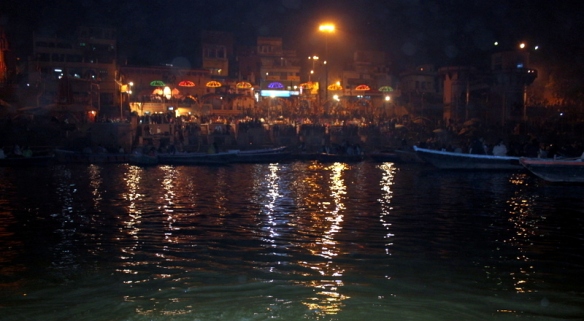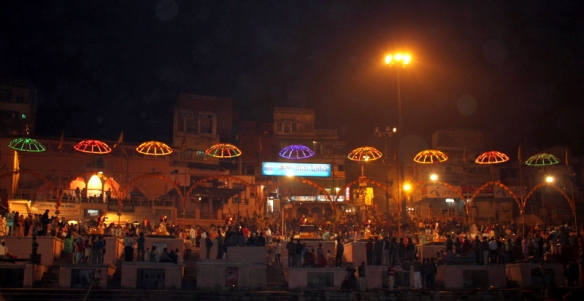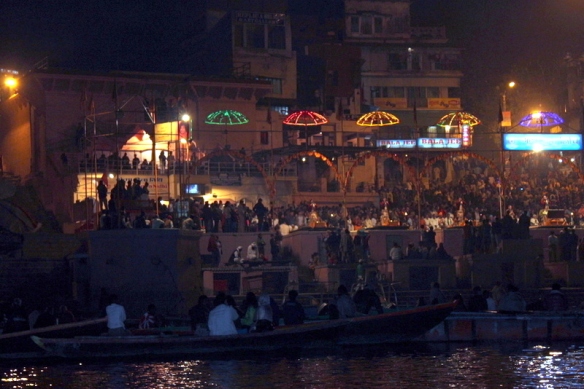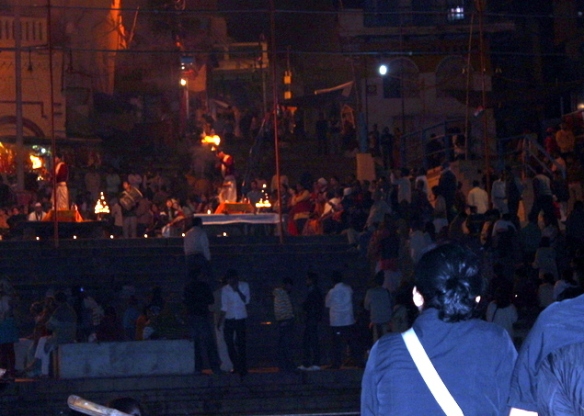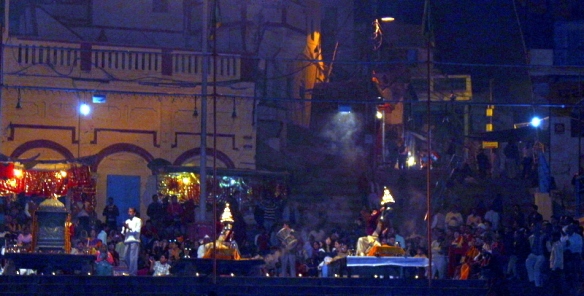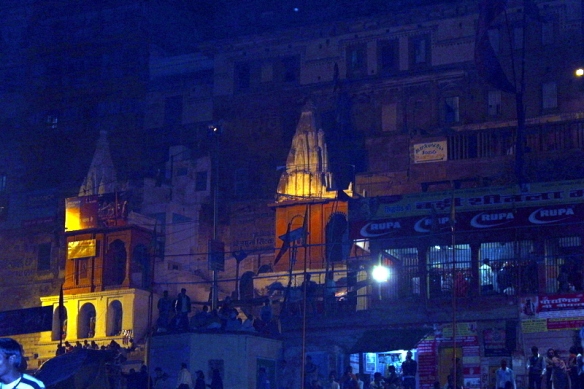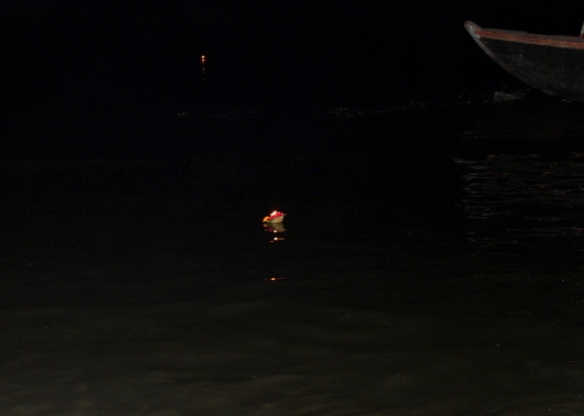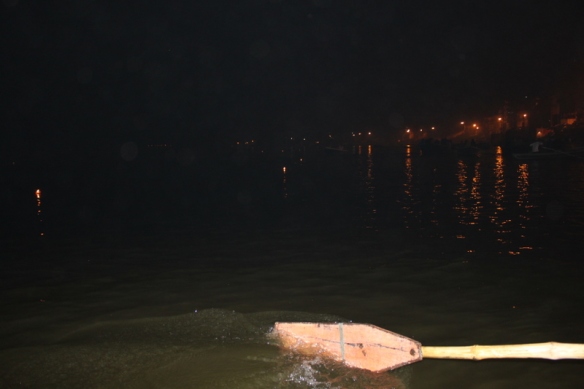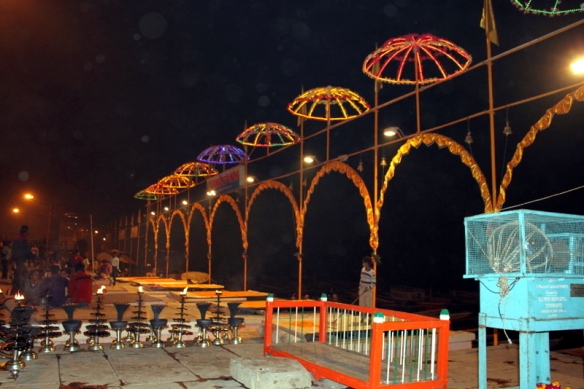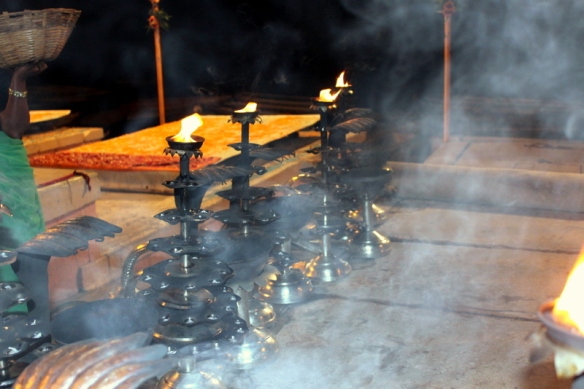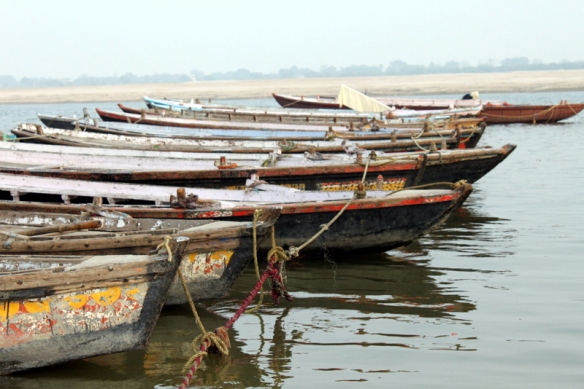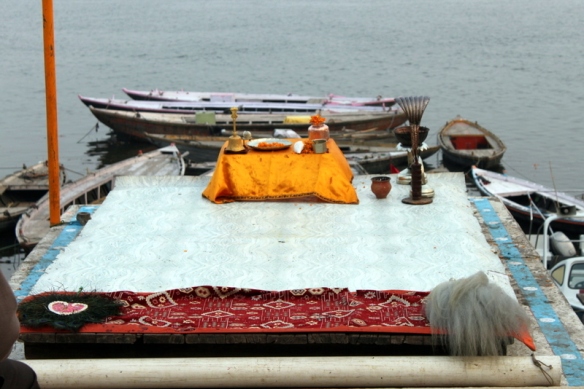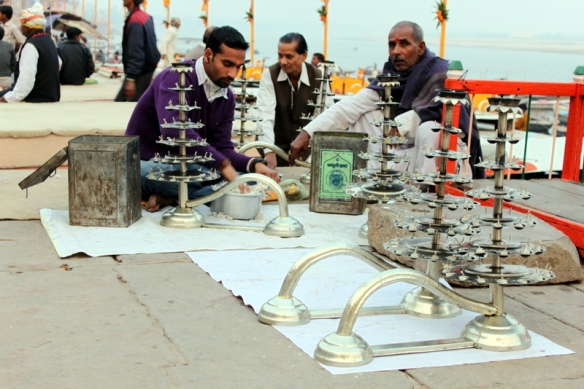It was evening by the time I sauntered around the ghat. It was time for a fiery tribute to the holy river – The Ganges.
As I walked towards the ghat, I saw people swarming, huddling, running, pushing each other. Suddenly, the sound of conch shells echoed the surroundings, marking the beginning of the Aarti. The priests truly displayed their lung’s power. 😛
Soon enough the incense sticks billowed the fragrant holy smoke, which engulfed the praying dias.
I wanted to get a glimpse of the priests performing the larger than life Aarti (prayer). Dasaswamedh Ghat is known for it’s evening Aarti. However the crowd gets to you. It was jam packed with the devotees. I couldn’t squeeze my self in between the people, even if I wanted to. It was like a wall of people. Moreover, I am vertically challenged. Damn! 😛 I tried clicking by raising my hands up and ended up with such ghastly photos. 😉
I decided to hop on a boat and sail on the Ganges. The Aarti was on and I was still in the mid way. I guess the time for Aarti is around 7 PM. It is usually a 1 hr affair. Man! It was a fabulous view. Everything about it was magnanimous. An orange hue enveloped the praying dias. It was almost like attending a rock concert. 😉
I realized, I was not the only one having my grey cells working. A boat sailing in front of me looked like this…
In the meantime, I started to chat with my boatman. I was curious about the ghats name so I probed him. He told me a rather startling revelation behind the name of Dasaswamedh Ghat. As the legend goes, Lord Brahma (Creator of the universe, as per Hindu mythology) sacrificed 10 horses on the banks of river Ganga to allow Lord Shiva mark his return to Varanasi. He was supposedly banished. Aah! I can’t recall why? This is what I like about mythology, there is a reason for every happening. Alas!
My boatman pointed towards the adjoining ghat as he rowed closer to the ultimate tribute. It was the Manikarnika Ghat. It is where the cremation happens. A ghat which liberates the soul from the cycle of birth and death. Now it was clear. I could instantly recall what I viewed while siting on those gigantic stairs near the banks – Life and Death in a single frame.
Snapping out of mythology, I inched closer to the yet so far tribute.
I looked around. There was a mad rush to reach to the praying dias. Hundreds of boats were lined up in front of the priests. All the boats were fully loaded with people.
It was impossible to get closer to the priests or to the praying dias.
Advisory: My boatman told me, if I come around the second time to witness the Aarti, I should be near the dias before 6 PM in order to click the close-ups.
So, I made peace with it and started to click.
A great lineup of priests held the camphor lit fiery lamps. Smoke oozed out from them that added to the dramatic representation of the Aarti. These pious lamps were wildly gyrated and swayed to the sound of the manjiras (Indian hand cymbals). The loud spiritual chants of the sanskrit verses were let loose out in the open. All the priests were in sync with each other. It almost looked like a possessed performance. However, it was a well choreographed, rehearsed and coordinated act.
I kept requesting my boatman to keep looking for space to move forward near to the dias. I was glad as he obliged. 🙂
Wow! The Aarti was transcendental…in a way. This electrifying puja is a must watch. What showman ship, display of sheer power and sweat, pure faith, mesmerized devotees all gyrating into the grandeur of the Aarti.
Once the Aarti was over, the dispersion began. In few minutes extreme silence pervaded. I was sitting and sailing through the calm waters absorbing the magnanimity of a spiritual belief. I spotted the shimmering Ganges. I had never seen something like that before. The light from the ghats shimmered its way to the Ganges.
The devotees made a wish / prayed and floated an earthen diya on a leaf.
There were innumerable diyas floating at night, illuminating the holy river. As if the stars had come down for a swim. It was pure magic. Totally surreal. The attainment of peace accompanied by the splashing of an oar was worth the experience.
I couldn’t have asked for more. Once at shore, I quickly reached out to the praying dias where the priests performed the puja. The crowd, once under a spell was now in motion. I was glad because I could click! 😉
The burnt camphor was still oozing out smoke from the now blackened lamps, covered in soot.
It was a welcome change from the cacophony of the city that sucked itself with loud blaring horns.
Kashi Vishwanath Temple
While retreating to my hotel room, I crossed the holiest temple of Varanasi – The Kashi Vishwanath Temple. I was also told to visit many other temples like Durga Temple, Bharat Mata Temple, Sankat Mochan etc…but now you know me well enough ;). For pure historical reasons, I went to view the Kashi Vishwanath temple, which was built by Maharani Ahilyabai Holkar.
A holy man was standing on the main road who offered his navigation skills to reach the temple. I merely followed him and went inside the narrowest lanes, fully loaded with shops on both the sides. I squeezed myself through the live army of people to reach the temple of the Lord Shiva. Some 300 meters before the temple, I had to take off my shoes and walk bare feet towards the temple.
Advisory: Please visit the temple at your own risk during the rainy season. Your feet might bite into slippery cow dung or filth.
This temple ranks amongst the highest in spiritual value. Man! I couldn’t fathom that a massive temple that speak volumes of it’s historic past was dangerously encroached by various concrete buildings that precariously surround it. The temple is extremely gray. Probably built out of grey mica stones. It houses the Jyotirlinga of Shiva.
Unfortunately the photography wasn’t allowed but it definitely had an old world charm. I have seen many temples but nothing like this one. The way the idols were kept, the deity room, the path ways. It was a great experience to live a life from the past.
In order to get out, I squeezed into the narrow lane and only faith could have got me out. 😉 I chose to walk my way back to my hotel by dodging the cows, bikes, cars, rickshaws and most of all the jaywalkers.
It was an experience worth living for. I found the city chaotic yet charming. I loved every bit of push, nudge, revelation, calmness, madness, serenity, spirituality that’s around this place. A historic city submerged in traditions, soaked in beliefs and afloat on faith is absolutely mind numbing yet insightful.
In my next blog I will be crossing the river Ganges to reveal the fort of Ram Nagar.

